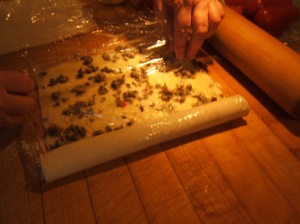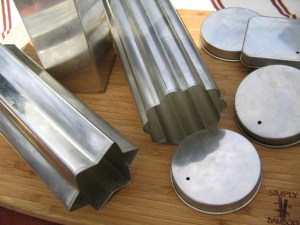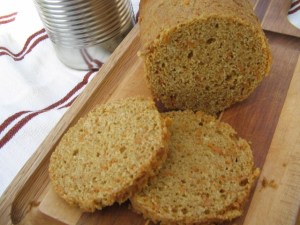This is the week of my birthday. How will I be celebrating it? Well, I’ll be putting in overtime at work (but my sweetie is taking me out to dinner). So, knowing how little time I’m going to have, I wanted to give you guys a couple of recipes in one post–elements for the gingerbread trifle.
First the great gingerbread. It received rave reviews from our guests at the tree-trimming tea. I think it worked equally well with both the butterscotch and the lemon filling. I used Laurie’s lemon curd recipe and thought the combo was fabulous.
The recipe is based on one from Gourmet.

The gingerbread was great but, truly, not pretty enough to photograph after the lava flow!
2 1/4 cups all-purpose flour
1 teaspoon baking soda
1 teaspoon ground ginger
1 teaspoon ground cinnamon
1/2 teaspoon nutmeg
1/2 teaspoon cardomom
1/4 teaspoon ground allspice
1/2 teaspoon salt
1 stick (1/2 cup) unsalted butter, well softened
2/3 cup molasses (not blackstrap)
2/3 cup packed dark brown sugar
2 large eggs
2 tablespoons finely grated (with a microplane) peeled fresh ginger
2/3 cup hot water
Put oven rack in the middle position and preheat oven to 350° F. Butter a 9-inch square baking pan.
Whisk together flour, baking soda, spices, and salt in a bowl.
Beat together butter, molasses, brown sugar, eggs, and ginger in a large bowl with an electric mixer at medium speed until combined. Reduce speed to low and beat in flour mixture until smooth, then add hot water and mix until combined (batter may appear curdled).
Pour batter into pan and bake until a wooden pick or skewer inserted in center of cake comes out clean, 35 to 40 minutes. Cool to warm in pan on a rack.
And here’s what I learned with this recipe. They were serious when they said “9-inch square baking pan.” I chose a slightly smaller pan, a silly inch smaller, who’d notice? Hmmm, my oven did. As the gingerbread oozed over the side of the pan, landed–and then burned–on the bottom of my oven, the stench of burning gingerbread permeated my house and my nostrils. The smell lasted for hours. Seriously I woke up the next morning with the house still smelling of burnt gingerbread. It was right there with the time I thought it would be a good idea to smoke a cigar in the house with my friend Sam. DON’T DO IT!!!

Tangy, sweet and lemony--made with lemons just picked from the garden
Enough ripe bright-skinned lemons–about three–to yield 1 tablespoon of grated zest and 1/2 cup strained juice
1/2 cup plus 2 tablespoons butter, cut up
4 egg yolks
1 whole egg
pinch of salt
1 1/4 cups sugar
Run 2 inches of water into the base pan of a double boiler and set it over medium heat to come to a brisk simmer.
Grate the zest, and juice the lemons.
Put the zest, juice, salt and cut-up butter in the top of the double boiler (off the water).
Beat the egg yolks and whole egg together at speed in a large bowl until they’re foamy; gradually add the sugar and beat until the mixture is pale yellow and very thick (the original says about five minutes –I find it never takes that long, more like three).
Scrape the egg mixture into the double boiler and set the top into the base over the simmering water. Begin whisking the mixture immediately. Cook it, whisking constantly, until it has thickened smoothly and is steaming hot, about 10 minutes. Be careful not to overcook the curd; it is done when it will coat a metal or wooden spoon heavily. (If you have a candy thermometer, it should read between 175 and 200.) Remove the upper pan from the hot water.
Pour the contents into sterilized jars and allow to cool uncovered, then cap the jars with sterilized lids. Or scrape it into a clean plastic container and use it up in a week or two. In any case, keep it the refrigerator.
This recipe comes from the wonderful Fancy Pantry by Helen Witty, unfortunately out of print, though used copies can be found.
Hazel
The butterscotch pudding, which was our alternative filling, could come from a packaged mix–if you can find it. (Don’t use one of those instant puddings; they taste horrible and the texture is disgusting.) But pudding is easy to make from scratch. I used a simple one from Betty Crocker’s Cookbook, but virtually any one will do.
Now, for assembling the trifle, though it’s not exactly a proper trifle because it lacks both alcohol and fruit. (It could have alcohol, of course, maybe a little spiced rum sprinkled over the gingerbread.)
The Trifle
2 cups whipping cream, beaten stiff
Slice the gingerbread and line a pretty glass bowl with the slices (and sprinkle it with a little rum if you like). Spoon the filling of your choice over the gingerbread. Pipe or spoon the whipped cream over it all. If you’re thinking of making it for a holiday party, I recommend getting out the cake decorating set and piping whipped-cream rosettes around the perimeter.
You can assemble this a couple of hours ahead of time, but don’t make it the day before you plan to serve it. The pudding will soak into the gingerbread and you’ll end up with mush.
Laurie
Read Full Post »








